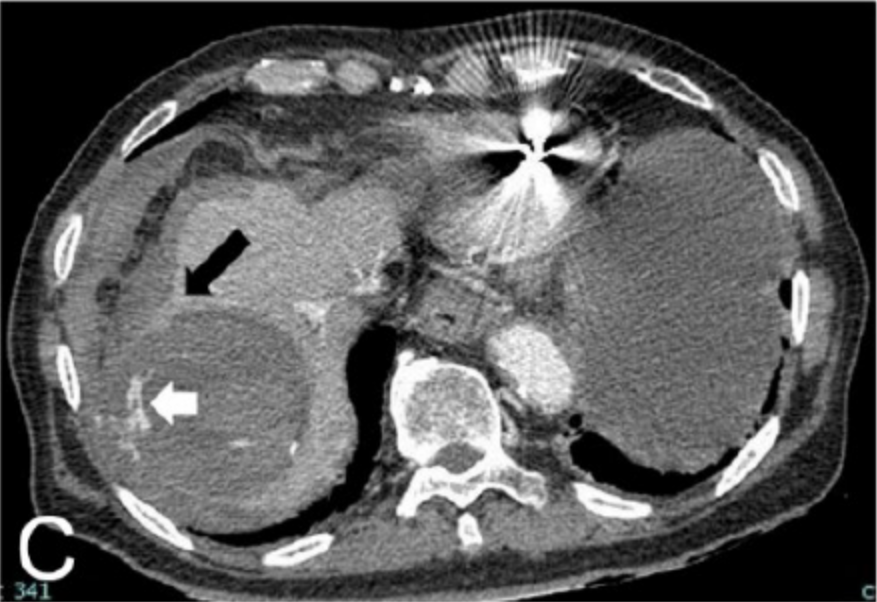Spontaneously Ruptured Hepatocellular Carcinoma Treated by Transarterial Embolization Compared with Conservative Treatment: Survival Outcome and Prognostic Factors
DOI:
https://doi.org/10.33192/Smj.2021.52Keywords:
Prognostic factors, survival outcome, ruptured hepatocellular carcinoma, transarterial embolizationAbstract
Objective: To report the survival outcome and prognostic factors in the patients with spontaneously ruptured hepatocellular carcinoma treated by transarterial embolization compared with conservative treatment.
Materials and Methods: A retrospective review of 89 patients who had spontaneous rupture of hepatocellular carcinoma (HCC) at Siriraj Hospital between January 2011 and February 2017 were enrolled. Ruptured HCC patients are diagnosed by clinical presentations of abdominal pain/distension, anemia/shock with dynamic liver computed tomography findings as: hemoperitoneum, focal discontinuity or tumor protrusion of the hepatic surface and/or active contrast material extravasation. We compared the survival outcome and prognostic factors of the ruptured HCC patients who received two treatment methods; conservative treatment and transarterial embolization (TAE).
Results: The cumulative median survival time of the ruptured HCC patients was significantly higher in the TAE group (81 days) than in the conservative treatment group (29 days) with p-value = 0.006. There were two significant predictors for post-treatment mortality. First, treatment modality in the TAE group showed a significantly lower mortality rate than in the conservative treatment group with a hazard ratio (HR) 0.454 (p-value = 0.003). Second, a pre-treatment high hematocrit level was a significant predictive factor for lower mortality than a low hematocrit level with a hazard ratio (HR) 0.946 (p-value = 0.016).
Conclusion: TAE results in a good clinical outcome and increased survival rate in the patients with ruptured HCC. A pre-treatment high hematocrit level was a good prognostic factor for the survival in ruptured HCC patients.
References
2. Somboon K, Siramolpiwat S, Vilaichone RK. Epidemiology and survival of hepatocellular carcinoma in the central region of Thailand. Asian Pac J Cancer Prev 2014;15(8):3567-70.
3. Chonprasertsuk S, Vilaichone RK. Epidemiology and treatment of hepatocellular carcinoma in Thailand. Japanese Journal of Clinical Oncology JJCO 2017;47(4)294-7.
4. Miyamoto M, Sudo T, Kuyama T. Spontaneous rupture of hepatocellular carcinoma: A review of 172 Japanese cases. Am J Gastroenterol 1991;86(1):67-71.
5. Yoshida H, Mamada Y, Taniai N, Uchida E. Spontaneous ruptured hepatocellular carcinoma: Hepatol Res 2016;46(1);13-21.
6. The Thai Association for the study of the liver. Thailand Guideline for Hepatocellular Carcinoma 2019:28.
7. The Thai Association for the study of the liver. Thailand Guideline for Hepatocellular Carcinoma 2016:3-10.
8. Kim HC, Yang DM, Jin W, Park SJ. The various manifestations of ruptured hepatocellular carcinoma: CT imaging findings. Abdom imaging 2008;33(6):633-42.
9. Eurvilaichit C, Kanjanapitak A. Hepatocellular carcinoma: treated with hepatic arterial embolization, an analysis of prognostic features in 150 cases. J Med Assoc Thai 2000;83:983-91.
10. Kaewwichian W, Munkong W, Lao-paiboon V, Pugkhem A, Bhudhisawasdi A. Clinical features, treatment outcomes and factors influencing survival of spontaneous ruptured hepatocellular carcinoma: A Srinagarind hospital-based study, 1997-2011 (abstract). Department of surgery, Faculty of Medicine Khonkaen university. Medical Library Collection 2012:1-10.
11. Charoenkajonchai S. Management and outcome of ruptured hepatocellular carcinoma. The Thai Journal of Surgery 2015;36(2):47-51.
12. Kerdsuknirun J, Vilaichone V, Vilaichone RK. Risk factors and prognosis of spontaneously ruptured hepatocellular carcinoma in Thailand. Asian Pac J Cancer Prev 2018;19(12):3629-34.
13. Aoki T, Kokudo N, Matsuyama Y, Izumi N, Ichida T, Kudo M, et al. Prognosis impact of spontaneous tumor rupture in the patients with hepatocellular carcinoma: an analysis of 1160 cases from a nationwide survey. Ann Surg 2014;259(3):532-42.
14. Leung KL, Lau WY, Lai PB, Yiu RY, Meng WC, Leow CK. Spontaneous rupture of hepatocellular carcinoma: conservative management and selective intervention: Single -center experience. Arch Surg 1999;134(10):1103-7.
15. Monroe EJ, Kogut MJ, Ingraham CR, Kwan SW, Hippe DS, Padia SA. Outcomes of emergent embolization of ruptured hepatocellular carcinoma in a western population. Clin Radiol 2015;70(7):730-5.
16. Butt AS, Hamid S, Butt N, Sharif F, Hag TUI, Jafri W. Is transarterial embolization a valuable treatment option for spontaneous rupture of hepatocellular carcinoma: experience from a tertiary care hospital of South-Asia. Hapatoma Res 2016;2:279-86.
17. Palidar Y, Khisti R, Yadav A, Mukund A, Sarin S. Outcome of conventional transarterial chemoembolization (cTACE) in the management of spontaneously ruptured hepatocellular carcinoma. Indian J Radiol Imaging 2019;29(2):177-81.
18. Ngamsombat C, Chaiyasoot W. Analysis of extrahepatic collateral arteries in transcatheter arterial chemoembolization of hepatocellular carcinoma. Siriraj Med J 2018;70(3):247-53.
19. Zhou C, Zu QQ, Wang B, Zhou CG, Shi HB, Liu S. Efficacy and prognostic factors of transarterial embolization as initial treatment of spontaneously ruptured hepatocellular carcinoma: a single-center retrospective analysis in 57 patients. Jpn J Radiol 2019;37(3):255-63.

Published
Versions
- 09-01-2024 (2)
- 01-06-2021 (1)
How to Cite
Issue
Section
License
Authors who publish with this journal agree to the following conditions:
Copyright Transfer
In submitting a manuscript, the authors acknowledge that the work will become the copyrighted property of Siriraj Medical Journal upon publication.
License
Articles are licensed under a Creative Commons Attribution-NonCommercial-NoDerivatives 4.0 International License (CC BY-NC-ND 4.0). This license allows for the sharing of the work for non-commercial purposes with proper attribution to the authors and the journal. However, it does not permit modifications or the creation of derivative works.
Sharing and Access
Authors are encouraged to share their article on their personal or institutional websites and through other non-commercial platforms. Doing so can increase readership and citations.













